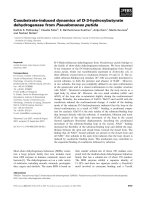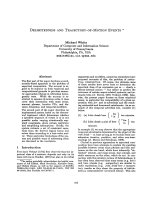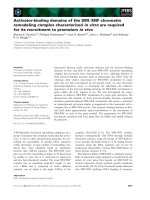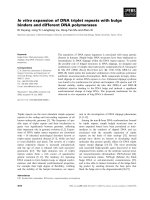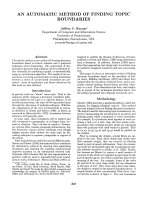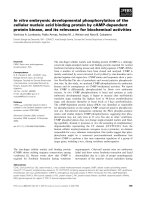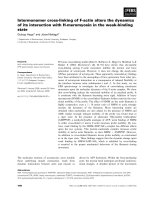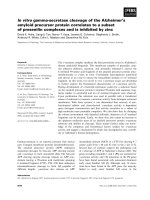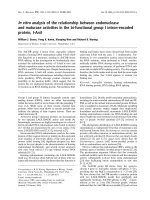Báo cáo khoa học: "In vitro dynamics of HIV-1 BF intersubtype recombinants genomic regions involved in the regulation of gene expression" pdf
Bạn đang xem bản rút gọn của tài liệu. Xem và tải ngay bản đầy đủ của tài liệu tại đây (373.86 KB, 9 trang )
BioMed Central
Page 1 of 9
(page number not for citation purposes)
Virology Journal
Open Access
Research
In vitro dynamics of HIV-1 BF intersubtype recombinants genomic
regions involved in the regulation of gene expression
Mauricio G Carobene*
†
, Christian Rodríguez Rodrígues
†
, Cristian A De
Candia, Gabriela Turk and Horacio Salomón
Address: National Reference Center for AIDS, Department of Microbiology, School of Medicine, University of Buenos Aires, Buenos Aires,
Argentina
Email: Mauricio G Carobene* - ; Christian Rodríguez Rodrígues - ; Cristian A De
Candia - ; Gabriela Turk - ; Horacio Salomón -
* Corresponding author †Equal contributors
Abstract
HIV-1 intersubtype recombination is a very common phenomenon that has been shown to
frequently affect different viral genomic regions. Vpr and Tat are viral proteins known to interact
with viral promoter (LTR) during the replication cycle. This interaction is mainly involved in the
regulation of viral gene expression, so, any structural changes in the LTR and/or these regulatory
proteins may have an important impact on viral replication and spread. It has been reported that
these genetic structures underwent recombination in BF variants widely spread in South America.
To gain more insight of the consequences of the BF intersubtype recombination phenomenon on
these different but functionally related genomic regions we designed and performed and in vitro
study that allowed the detection and recovery of intersubtype recombinants sequences and its
subsequent analysis. Our results indicate that recombination affects differentially these regions,
showing evidence of a time-space relationship between the changes observed in the viral promoter
and the ones observed in the Vpr/Tat coding region. This supports the idea of intersubtype
recombination as a mechanism that promotes biological adaptation and compensates fitness
variations.
Background
Recombination among retroviral genomes was first docu-
mented in avian tumour viruses by Vogt et al in 1971 [1]
and subsequently in other retroviruses [2,3]. This phe-
nomenon occurs before integration at a high rate along
the reverse transcription stage. It is dependent on co-pack-
aging of two different viral genomes [4,5], and provides a
powerful mechanism to rapidly increase viral sequence
diversity [6-8].
It has now become evident that HIV recombination is a
very common event and in areas with different circulating
subtypes, recombinant viruses may even predominate. To
date, more than 40 circulating recombinant forms (CRFs)
have been described (Los Alamos HIV Database) reinforc-
ing the idea that HIV-1 intersubtype recombination is a
very effective way to augment variability and to improve
viral fitness [9].
In previous studies, our results showed that the epidemic
in Argentina is characterized by the high prevalence of a
Published: 16 July 2009
Virology Journal 2009, 6:107 doi:10.1186/1743-422X-6-107
Received: 14 May 2009
Accepted: 16 July 2009
This article is available from: />© 2009 Carobene et al; licensee BioMed Central Ltd.
This is an Open Access article distributed under the terms of the Creative Commons Attribution License ( />),
which permits unrestricted use, distribution, and reproduction in any medium, provided the original work is properly cited.
Virology Journal 2009, 6:107 />Page 2 of 9
(page number not for citation purposes)
circulating recombinant form, CRF12_ BF and many
related BF recombinant forms [10-13]. Molecular studies
on these variants showed that recombination frequently
affected genomic regions involved in regulating viral gene
expression, replication, and interaction with the host
immune system, eventually leading to remarkable func-
tional consequences [14,15].
Transcriptional activation of HIV-1 gene expression is
controlled in part by the interaction between cellular and
viral transcription factors and the HIV-1 long terminal
repeat sequences (LTR). Tat is a viral transactivator that
activates HIV transcription through complex interactions
with RNA and host cell factors, while Vpr, a small virion-
associated protein, has been shown to play multiple func-
tions in the viral replication cycle including transactiva-
tion of viral [16] and host cell genes, regulation of the
reverse-transcription process accuracy, viral DNA nuclear
import, cell cycle progression, and apoptosis regulation.
As stated above, Vpr and Tat are viral proteins known to
interact with LTR and regulate gene expression. Then, var-
iations in LTR and/or these regulatory proteins may have
an important impact on viral replication and spread.
Thus, the aim of this study was to gain more insight of the
consequences of the BF intersubtype recombination phe-
nomenon on the different but functionally related
genomic regions LTR and Vpr/Tat, through the develop-
ment of an in vitro time-course experiment that allowed
the detection and recovery of intersubtype recombinants
sequences and its subsequent analysis.
Results
Detection of intersubtype recombinants
Intersubtype recombinant forms were first detected by
PCR amplification (figure 1) of the Vpr/Tat and LTR-Gag
regions at days 3 and 7, respectively. Although different
amounts of template DNA were used, no LTR-Gag recom-
binants were detected before day 7. Recombinant PCR
Detection of BF intersubtype recombinant genomes by PCR amplificationFigure 1
Detection of BF intersubtype recombinant genomes by PCR amplification. Proviral DNA found in samples from
mono (B or F Subtype) and dual-infected (B+F) cultures was used to obtain four different amplicons from the genomics regions
under study. Primers combinations and viral strains (B, F or FB) present in each cell culture are indicated (as described in Meth-
ods). Upper and lower panels show the result of the amplification of the LTR-Gag and Vpr/Tat regions, respectively. Intersub-
type recombinant PCR products are indicated by arrows. Positive and negative controls were included in the reactions.
Virology Journal 2009, 6:107 />Page 3 of 9
(page number not for citation purposes)
products from days 3, 7, 10 and 18 of the Vpr-Tat region,
and from days 7, 10 and 18 of LTR-Gag region were
cloned into a commercial vector and automatically
sequenced. Both BF and FB primer combinations were
used in each amplification reaction. A total of 61 Vpr-Tat
and 68 LTR-Gag sequences were obtained, and an exten-
sive molecular analysis was carried out.
LTR and Vpr-Tat recombinant sequences analysis
Molecular analysis of the viral promoter sequences was
focused on breakpoint patterns, and sequence changes in
transcription factors binding sites and regions involved in
RNA secondary structures.
LTR-Gag sequences showed two patterns of breakpoints
distribution: pattern I was defined by a recombination
breakpoint located in nucleotide position – 327 in the
LTR modulatory region, while pattern II presented a
recombination breakpoint in nucleotide position 790,
just prior to the p17 Gag start codon (positions are based
on HXB2 numbering). Regarding the latter, naturally
occurring BF recombinants also frequently showed this
recombination pattern (data not shown). As depicted in
table 1, frequency of sequences showing pattern I or II
changed over the time.
The pattern frequency analysis, performed in the context
of the BF or FB recombinant nature of the sequences and
sampling day (7, 10 and 18), showed that pattern II was
always the most frequently found, even though the coex-
istence of pattern I was evident in samples from days 7
and 10. This was observed in both the BF or FB groups of
sequences.
The TAR sequence, an important regulatory element posi-
tioned immediately after the transcription starting site (nt
+1 to +59) also showed a high level of conservation
between recombinant sequences and over time. A few
sequences presented nucleotides changes located in the
stem region. Two sequences from day 7, exhibited an
A→G substitution at position +28, and one sequence
from day 18 had G→A at position +27. Also 5 sequences,
1 from day 7, 1 from day 10 and 3 from day 18, presented
an A→G substitution at position +15. Its important to
highlight that this change has been documented before as
present in the prototypic BF recombinant sequence
CRF12_BF [14].
The dimerization initiation signal (DIS) is a 6 nt palindro-
mic sequence located at the loop of the proposed stem-
loop 1 (SL1) in the 5' untranslated region of the HIV-1
genome. It plays an important role in both RNA dimeriza-
tion and RNA packaging. SL1 from the parental B and F
subtypes only differ in their DIS hexanucleotide. The anal-
ysis showed a high conservation of SL1 in all the recom-
binant sequences. BF or FB recombinants conserved the
intact F (GUGCAC) or B (GCGCGC) DIS sequence,
respectively.
Overall, analysis of LTR variability in major regulatory
sites was performed, including NFAT, C-ETS, Core NRE,
TCF-1α, AP-1, RBF2, C/EBPI, NFκB (I, II), SP1 (I, II, II),
TATA Box (CATATAA), and E-Box (USF-binding site). A
high degree of conservation was observed in all of them
but in NFκB and Sp1 sites.
The HIV-1 promoter contains 3 Sp1 and 2 NF-kB binding
sites that regulate gene expression via the recruitment of
both activating and repressing complexes.
Analysis of the three Sp1 sites showed that Sp1I
(GGGGAGTGGC) site was found to be conserved among
all the recombinant sequences, and that Sp1II was the
most frequently affected by nucleotide changes, followed
by Sp1III. On day 7, 27.3% and 22.7% of the sequences
harbored non-parental nucleotide changes at Sp1 II and
Sp1III binding sites, respectively, changing to 62.5% and
37.5% at day 10, and to 59% and 40.9% at day 18 of the
time-course experiment (Figure 2). Position 5 in the 10-
bp Sp1 II site (TGGGCGGGAC) and positions 9 and 10 in
the Sp1 III (GAGGCGTGGC) were the most frequently
changed. Nucleotides were substituted for a T or an A.
Regarding NF-κB sites (GGGACTTTCC), also an increas-
ing number of sequences presented mutations in both
sites I and II over the time span (Figure 2). Nevertheless,
site II was found to be conserved among the sequences
from day 7. Nucleotide changes were observed in posi-
tions 9 and 10 (GGGACTTTCC), and 5 and 10
(GGGACTTTCC) of the NF-κB II and NF-κB I sites, respec-
tively.
In contrast with the observed for the viral promoter
sequences, Vpr/Tat sequences displayed a less restricted
recombination breakpoints distribution. Considering
this, sequence analysis was performed taking into account
if the breakpoint was located in the Vpr or in the Tat cod-
ing region from a total of 61 sequences, 63.9% (n = 39)
showed recombination breakpoints in the Vpr coding
Table 1: Distribution and frequency of recombination patterns in
the LTR/Gag sequences
Day Pattern I Pattern II Total
7 9 (40.9%) 13 (59.1%) 22
10 7 (29.2%) 17 (70.8%) 24
18 - 22 (100%) 22
Virology Journal 2009, 6:107 />Page 4 of 9
(page number not for citation purposes)
region (Pattern Vpr), and 36.1% (n = 22) in the Tat first
exon region (Pattern Tat). As shown in table 2, in this case
the recombination pattern also changed over time becom-
ing more frequent the sequences presenting a recombina-
tion breakpoint in the Vpr.
The analysis of nucleotide positions involved in recombi-
nation showed that the most frequently affected ones
were: 5757–59, 5766–68, 5788–90 (Vpr residues L67, I70
and R77, respectively), 5855–57, 5864–66, and 5876–78
(Tat residues E9, K12 and S16, respectively).
Vpr sequences encompassing aminoacids 55 to 96 (α-
helix 3 and carboxi terminal domains) were studied. The
α-helix 3 is thought to account for the formation of Vpr
dimers and/or for the interaction with cellular partners,
while the C terminal domain has been shown to partici-
pate in cell-cycle arrest, one of the most important func-
tion ascribed to Vpr.
Noteworthy, Q77R, a substitution not present in the
parental strains used in this study, was found in the Vpr/
Tat recombinant sequences. Moreover, its frequency was
found to be on the increase as follows: in 14.3% of the
sequences from day 3 (2/15), 23.5% on day 7 (4/17),
26.7% on day 10 (4/15) and 60% on day 18 (9/15).
Sequences harboring Q77H substitution were not found.
Frequency of this Q77R in naturally occurring subtype B,
F and BF Vpr sequences was found to be 47.8% (n = 257),
11.8% (n = 17) and 26% (n = 50), respectively. All the
analyzed sequences were obtained from Los Alamos
Sequence Database.
No changes were observed in Vpr residues L67 and I70 in
the analyzed sequences. As above mentioned, codons for
theses residues were frequently affected by recombination
events.
Frequency of sequences harboring mutations in SpI and NF-κB binding sites over the time-course experimentFigure 2
Frequency of sequences harboring mutations in SpI and NF-κB binding sites over the time-course experiment.
Diagram depicts an schematic representation of the NF-κB and SpI sites distribution in the HIV-1 LTR U3 region and the fre-
quency (expressed as percentages) of sequences presenting mutations in NF-κB or Sp1 binding sites in relation to each time
point.
Table 2: Distribution and frequency of recombination patterns in
Vpr/Tat sequences
Day Pattern Vpr Pattern Tat Total
3 6 (42.8%) 8 (57.2%) 14
7 9 (52.9%) 8 (47.1%) 17
10 11 (73.3%) 4 (26.7%) 15
18 13 (86.7%) 2 (13.3%) 15
Virology Journal 2009, 6:107 />Page 5 of 9
(page number not for citation purposes)
T84I substitution was also present in the recombinant
sequences (30.9% of them) and always associated to the
Q residue at position 77. This aminoacidic change is not
present in the parental B or F1 strains used in this study
and it has been found in approximately 50% of the natu-
rally occurring BF recombinants.
Other important aminoacidic positions, A59, S79, R80,
R90 S94 and S96 were analyzed. A59 has been shown to
be involved in Vpr protein incorporation into virions
[17,18], while S79, R80, R90, S94 and S96 have been
directly related to the cell-cycle arrest function [19]. Phos-
phorylation of 79S, 94S and 96S has been suggested to
regulate a putative nuclear localization signal (NLS) func-
tion [20], and changes in these positions may affect pro-
tein localization. Besides, it has been reported that
substitutions in positions 80 and 90 impaired the G2-
arrest and apoptotic activities without affecting the
nuclear envelope localization [21].
One sequence from day 7 and 1 from day 10 (3.3%) har-
bored the A59T substitution, 2 from day 7 and 1 from day
10 (4.9%) harbored the S79N, 1 from day 10 (1.6%) har-
bored the S94V alone, and 9 (14.7%) from day 18 har-
bored both S94V and S96P, simultaneously. Our results
also exhibited that all 9 sequences harboring S94V and
S96P also harbored R77Q and T84I.
Regarding positions 80 and 90, none of the sequences pre-
sented changes in position R80, but R90K substitution
was found in 1 sequence from day 7 (5.9%) and 2
sequences from day 10 (13.3%), and R90E substitution
was found in 9 sequences from day 18 (60%).
On the other hand, the Tat N-terminal (residues 1–21),
cystein-rich (residues 22–37), and core (residues 38–48),
coding sequences were analyzed. These 3 domains are
also known as Tat activation domain.
As regards the Tat N-terminal or acidic domain, it is pre-
dicted to form an α-helix. In addition to the negatively
charged amino acids placed in this domain, B subtype Tat
has 2 positively charged residues (R7 and K12) that are
likely to stabilize the secondary structure, while F1 sub-
type has N in the above mentioned positions.
These 2 positions were analyzed together, i.e. R7-K12 or
N7-N12. Our findings showed that R7-K12 and N7-N12
co-existed in samples from day 3, 7 and 10, with a mean
frequency of 32% and 35%, respectively. Nevertheless, by
day 18 N7-N12 was found in 80% of the sequences. Of
the two possible combinations between these 2 patterns,
R7-N12 and N7-K12, we only found the former in 12% of
the sequences from day 7, 10 and in 13% of the sequences
from day 18.
To note, at the end of our experiment (day 18), 85% of the
sequences harbored the N7-N12 pattern. This association
has also been frequently observed in naturally occurring
BF recombinants Tat sequences [14].
Q17, a highly conserved residue in B and F1 Tat proteins,
is frequently changed to K or R in natural BF recombinants
(14.7%, n = 61) (sequences taken from Los Alamos Data-
base). Q17K substitution was found in 13.3% of the
sequences from day 18 only. N24K substitution, not
present in the parental B or F but found in the prototypic
BF CRF12_BF and other natural BF recombinants, was
found in 2 sequences, one from day 7 and 1 from day 18.
R29, another substitution typically observed in natural BF
recombinants, was found in 41.8% of the sequences. This
frequency increased over time, being 18% on day 3, 31%
on day 7, 34% on day 10 and 78.5% on day 18.
K28, target for PCAF and p300 acetyltransferases and cru-
cial for transcriptional activation, K41, essential for Tat
activity [22,23], and the cystein residues present in the C
rich domain, were found to be conserved in all the
sequences.
Relative fitness evaluation
After completing the sequences analysis we aimed at
determining if recombination had a measurable impact
on viral population fitness, and infectivity was used as a
representative value of it. Thus, mono (B and F) or dual
(B+F) infected cell cultures supernatants were titrated by
p24 antigen concentration and used to infect GHOST X4
cell cultures. At 48-h post-infection, percentage of GFP (+)
cells was measured by FACS. Results showed a slight but
significant (p < 0.05) increase in infectivity for the B+F
supernatant from day 18 (26.5%) when compared with B
(21.1%) and F (20.5%) (Figure 3).
Discussion
Interactions between the cis-acting elements present in
the viral promoter (LTR), the viral proteins and the tran-
scription factors present in the host cell, influence the lev-
els of viral gene expression under a wide variety of
conditions. The LTR, although not absolutely necessary
for viral replication, responds to activation signals that
stimulate its activity increasing the rate of viral produc-
tion.
In this report we present data that shows how the inter-
subtype recombination phenomenon impacts at the
sequence level, on two different but functional related
regions of the HIV-1 genome: LTR and Vpr-Tat. The results
indicate that BF intersubtype recombination occurs in a
space-time fashion, since this phenomenon took place
first in the Vpr-Tat region and later on in the LTR-Gag
region. Significant differences were found regarding
Virology Journal 2009, 6:107 />Page 6 of 9
(page number not for citation purposes)
recombination breakpoints, in terms of its number and
distribution over the time. The number of breakpoints
was observed to be higher in the former than in the latter,
and breakpoints in the LTR showed a more restricted loca-
tion pattern. The small number of breakpoints within the
LTR could be ascribed to the fact that recombinants with
breakpoints in this region might likely tend to be selected
against.
Analysis of the major transcription factor binding sites
present in the LTR revealed a high conservation of most of
them. Nevertheless, a remarkable high frequency of
sequences harboring mutations in the NFkβ and Sp1
binding sites was found. It has been recently demon-
strated that NFkβ and Sp1 sites present in the HIV-1 LTR
influence both, the gene expression levels and the
dynamic switching between active or latent infection [24].
Mutations in NFkβ and Sp1 sites found in the analyzed
recombinant sequences might have a significant impact
on replication capacity of variants harboring them, since
theses sequences seem to be positively selected over time.
Of the three Sp1 sites found in the U3 region of the viral
promoter, mutations were highly frequent in site II, and to
a lesser extent in site III. Mutations in these sites have been
shown to be strongly correlated to alterations in viral rep-
lication [24,25]. The absence of sequences harboring
mutations in the Sp1I site underscores its importance in
viral gene regulation.
Regarding NFkβ, we found an increasing number of muta-
tions affecting both sites over time. Site I was the first to
show nucleotide changes, but mutations were soon
detected in site II. It has been shown that functional roles
of these two sites are not redundant, having site I an acti-
vating role and site II a repressing one. Thus, mutations
affecting these sites in different time points could function
as a delicate mechanism of regulation of viral gene expres-
sion by compensating any losses or gains in transcription
levels. This mechanism may play a key role in the adapta-
tion process of recombinant variants.
The observed structural variations on the Vpr-Tat coding
region from recombinant sequences may be related to
changes found in the LTR, since it is well documented that
transactivation of HIV-1 gene expression is mainly
induced by Tat through the interaction with TAR, and by
the interaction of Vpr with cis-acting elements, including
NF-κB, Sp1, C/EBP and the GRE enhancer sequences
[16,26,27]. Vpr has also been shown to interact with the
ubiquitous cellular transcription factor Sp1 [28] and that
can directly bind to p300 via interaction the C-terminal α-
helix 3 of the protein [29] suggesting that Vpr may act by
recruiting them to the HIV-1 promoter thus enhancing
viral expression.
On the other hand, the high frequency of the R77Q sub-
stitution found in the recombinant sequences highlights
the relevance of this residue in the context of genomes
evolution after intersubtype recombination events.
Although controversial, some reports showed that R77Q
is frequently found in viruses isolated from long term
non-progressor HIV-1 infected patients. Experimental
results revealed that viruses harboring this mutation have
diminished their capacity to induce apoptosis, or on the
contrary, the presence of such mutation would have a
moderate positive effect on cell viability thus increasing
the viral replication capacity [30-32]. As shown in results,
sequences representing recombinant viral population at
the end of the experiment also exhibited a high frequency
of mutations in the Vpr residue R90 that has been shown
to affect one of its more relevant functions, i.e. cell cycle
control and apoptosis [21]. Altogether, this data suggest
that rapid and significant changes in viral pathogenesis
may result from intersubtype recombination affecting this
accessory protein.
Despite the observed changes in Tat N-terminal (acidic,
cystein rich and core regions) coding sequences have not
been directly associated to specific protein functions,
recombinant sequences analyzed here show alterations
that have also been observed in naturally occurring BF
recombinants, suggesting a relationship between recom-
bination events and structural/functional modifications.
Finally, the evaluation of relative viral fitness revealed a
slight but significant increase in infectivity of the viral
population originated from the B+F dual infected cell cul-
Relative infectivity of mono (B or F Subtype) and dual-infected (B+F) cell culture viral populationsFigure 3
Relative infectivity of mono (B or F Subtype) and
dual-infected (B+F) cell culture viral populations.
Supernatant from mono an dual-infected cultures from day
18 were collected and used to infect GHOST indicator cell
line. Viral inoculums were standardized by P24 antigen con-
tent. Forty eight hour post infection percentage of infected
cells was measured by flow cytometry. The mean percentage
of infected cells for each case are shown. Error bars indicate
standard errors.
Virology Journal 2009, 6:107 />Page 7 of 9
(page number not for citation purposes)
ture at the end of the time course-experiment. Therefore,
it can be hypothesized that after several rounds of recom-
bination events and selection, this mixed population may
become enriched in viral forms with higher replication
capacity, underscoring the relationship between sequence
evolution and fitness variations.
Conclusion
Considering the stated above, one may speculate that the
observed changes in the studied viral promoter and/or the
Vpr-Tat sequence are a consequence of a mechanism that
promotes biological adaptation and compensates any
possible fitness loss after recombination involving these
regions. Although the experimental model developed in
this work only allowed to identify a limited number of
recombinant forms, our results demonstrate that the
study of recombination patterns evolution has the poten-
tial to provide insight into key dependencies between
intra- and inter-viral genomic regions.
In summary, this work provides useful data on the conse-
quences of HIV-1 intersubtype recombination, opening a
window to better understand its role in generating novel
strains and inducing viral fitness changes, which would
have important implications on HIV-1 epidemiology and
pathogenesis.
Methods
Cells and viruses
NL4-3 (GenBank: AF324493) and 93BR020 (GenBank:
AF005494
) strains were used for B and F subtypes respec-
tively. Viral infections were carried out in MT2 cell cul-
tures grown in RPMI 1640 medium (Cellgro; Mediatech,
Herndon, VA) supplemented with 10% FBS, penicillin/
streptomycin (100 U/ml, 100 mg/ml), L-glutamina (2
mM) and sodium bicarbonate. GHOST X4 cells, used to
perform relative infectivity assay, were grown in DMEM
medium (Cellgro; Mediatech, Herndon, VA) supple-
mented with 10% FBS, L-glutamine (2 mM), penicillin/
streptomycin (100 U/ml, 100 mg/ml), G418 (300 ug/ml),
hygromycin (100 ug/ml) and puromycin (1 ug/ml). Cell
lines and viral strains were obtained through the AIDS
Research and Reference Reagent Program
sreagent.org.
Viral Infections
For viral infections, 2 × 10
6
MT2 cells were infected with B
or F and B+F viruses separately at a multiplicity of infec-
tion (MOI) of 0.01 IU/cell. B and F were mixed before
cells addition, and then incubated for 2 hs at 37°C in a
5% CO2-containing atmosphere.
Viral infections were maintained up to 18 days post-infec-
tion by adding fresh cells when cytopathic effect was evi-
dent: 2 × 10
6
uninfected cells were mixed with 500 ul of
double and single-infected cultures (cells plus superna-
tant). Sampling was performed at days 3, 7 and 10. Cell
culture samples were centrifuged for 10 minutes at 2500
RPMs in order to separate cells from supernatants. Pel-
leted cells and aliquoted supernatants were stored at -
80°C until use.
PCR
Subtype-specific PCRs were designed to amplify the provi-
ral genome regions under study: one comprising the viral
promoter and part of the Gag coding sequence (positions
128 to 944 in the HXB2 numbering), and the other
including the 3' half of Vpr and 5' half of Tat coding
sequences (positions 5683 to 5973 in the HXB2 number-
ing). Primers for these reactions were designed based on
parental B and F subtype sequences: LTR-Gag B fw 5'-GCA
AGT AGA AGA GGC CAA TA-3', LTR-Gag B rev 5'-GTT
AAT CCT GGC CTT TTA G-3', LTR-Gag F fw 5'-GGA GGT
AGA AAA GGC CAA TG-3', LTR-Gag rev 5'-CTT GAT CCA
GGC CTT CTA G-3', Vpr-Tat B fw 5'-TA GGA CAA CAT
ATC TAT GAA ACT-3', Vpr-Tat B rev 5'-AA AAG CCT TAG
GCA TCT CCT ATG-3', Vpr-Tat F fw 5'-TA GGA CAA CAT
ATC TAT AAC ACC-3', Vpr-Tat F rev 5'-GA AGG GCT TAG
GCA TCT CCT ATG-3'. Cycling conditions used were:
95°C for 5 min, followed by 35 cycles of 95°C 45 s, 60°C
45 s, 72°C 1 min for the LTR-Gag region, or 35 cycles of
95°C 45 s, 58°C 20 s, 72°C 1 min, for the Vpr-Tat region,
and a final extension of 5 minute to 72°C.
Cellular DNA was quantified to control for the input of
genetic material in each PCR reaction
pNL4-3 and p93BR020.1, as well as a plasmid containing
the Vpr-Tat genomic region of CRF12_BF (ARMA159)
obtained in a previous work (unpublished) were used as
controls for the amplification reactions.
The two possible selected recombinant structures, B/F or
F/B, were detected by using primer combinations: LTR-
Gag B fw/LTR-Gag F rev or LTR-Gag F fw/LTR-Gag B rev,
and Vpr-Tat B fw/Vpr-Tat F rev or Vpr-Tat F fw/Vpr-Tat B
rev. The specificity of each primer combination was tested
(Figure 1).
Intersubtype recombinant (from dual-infected cultures)
as well as B and F (from mono-infected cultures) PCR
products were gel-purified (QIAquick gel extraction kit,
QIAGEN GmbH, Germany) and cloned into a commer-
cial cloning vector (pGEM T Easy, Promega, USA).
Nucleotide sequencing was performed using a Big Dye
Terminator sequencing kit (Amersham, Sweden) and an
automatic sequencer (Applied Biosystems DNA sequencer
3100).
Virology Journal 2009, 6:107 />Page 8 of 9
(page number not for citation purposes)
Sequence analysis
A multiple alignment of the sequences with reference
sequences was performed using Clustal W, and visually
corrected with the BioEdit version 5.0.9 program http://
www.mbio.ncsu.edu/BioEdit/bioedit.html.
Sequences were analyzed using a tool for the detection of
intersubtype genomic recombination in HIV-1, available
online at />. This method uses a
probabilistic approach to compare a sequence to a multi-
ple alignment of a sequence family[33]. Recombination
events were confirmed by bootscanning analysis as imple-
mented in the SimPlot v.3.5.1 program http://
www.welch.jhu.edu.
LTR sequences were analyzed in search of transcription
factors binding sites (TFBS) using a web-based method
(TFSEARCH Data Base, available at />).
Mutations analysis was performed by visual inspection of
the sequences.
B and F sequences from mono infected cultures were used
as control for sequence stability over the time.
Infectivity Assay
Relative infectivity assay was performed by infecting
GHOST X4 cell cultures with mono (B and F) and dual
(B+F) culture supernatans from sampling days 3, 7, 10
and 18, and the proportion of GFP+ cells was measured
48 hours post-infection using a FACScalibur flow cytome-
ter (BD Biosciences, San Jose, CA). The percentage of GFP
expression was normalized to the control uninfected cell
culture. Culture supernatans were previously titrated by
p24 antigen concentration through a commercial ELISA
assay (Murex, Abbott, USA), including a calibration curve.
All experiments were performed in duplicate.
Statistical analysis
All data was expressed as mean ± SD. Significance (p <
0.05) between means of two experimental groups was
evaluated using the Student's t test for independent sam-
ples (Primer of biostatistics 4.02 statistical program).
Competing interests
The authors declare that they have no competing interests.
Authors' contributions
MC and CCR contributed equally to this work designing
and performing the experiments and during the manu-
script preparation. CDC participated providing technical
help during cloning and sequencing procedures. GT con-
tribute to design the study and helped with phylogenetic
analysis and data interpretation. HS supervised experi-
mental design and writing of the manuscript. All authors
read and approved the final manuscript.
Acknowledgements
We thank Sergio Mazzini for his excellent work in manuscript editing and
language revision, and to Andrea Rubio and Monica Saracco for their tech-
nical assistance on automated sequencing and flow cytometry, respectively.
MC, CRR, CDC and GT were supported by the Argentinean National
Research Council (CONICET). This research has been partially funded by
the Argentinean Agency for the Promotion of Science and Technology
(ANPCYT, Grant N° 01276).
References
1. Vogt PK: Genetically stable reassortment of markers during
mixed infection with avian tumor viruses. Virology 1971,
46:947-952.
2. Clavel F, Hoggan MD, Willey RL, Strebel K, Martin MA, Repaske R:
Genetic recombination of human immunodeficiency virus. J
Virol 1989, 63:1455-1459.
3. Wong PK, McCarter JA: Genetic studies of temperature-sensi-
tive mutants of Moloney-murine leukemia virus. Virology 1973,
53:319-326.
4. Hu WS, Temin HM: Genetic consequences of packaging two
RNA genomes in one retroviral particle: pseudodiploidy and
high rate of genetic recombination. Proc Natl Acad Sci USA 1990,
87:1556-1560.
5. Hu WS, Temin HM: Retroviral recombination and reverse
transcription. Science 1990, 250:1227-1233.
6. Bocharov G, Ford NJ, Edwards J, Breinig T, Wain-Hobson S, Meyer-
hans A: A genetic-algorithm approach to simulating human
immunodeficiency virus evolution reveals the strong impact
of multiply infected cells and recombination. J Gen Virol 2005,
86:3109-3118.
7. Charpentier C, Nora T, Tenaillon O, Clavel F, Hance AJ: Extensive
recombination among human immunodeficiency virus type
1 quasispecies makes an important contribution to viral
diversity in individual patients. J Virol 2006, 80:2472-2482.
8. Malim MH, Emerman M: HIV-1 sequence variation: drift, shift,
and attenuation. Cell 2001, 104:469-472.
9. Vijay NN, Vasantika , Ajmani R, Perelson AS, Dixit NM: Recombina-
tion increases human immunodeficiency virus fitness, but
not necessarily diversity. J Gen Virol 2008, 89:1467-1477.
10. Avila MM, Pando MA, Carrion G, Peralta LM, Salomon H, Carrillo
MG, Sanchez J, Maulen S, Hierholzer J, Marinello M, Negrete M, Rus-
sell KL, Carr JK: Two HIV-1 epidemics in Argentina: different
genetic subtypes associated with different risk groups. J
Acquir Immune Defic Syndr 2002, 29:422-426.
11. Carr JK, Avila M, Gomez Carrillo M, Salomon H, Hierholzer J, Watan-
aveeradej V, Pando MA, Negrete M, Russell KL, Sanchez J, Birx DL,
Andrade R, Vinoles J, McCutchan FE: Diverse BF recombinants
have spread widely since the introduction of HIV-1 into
South America. Aids 2001, 15:F41-47.
12. Gomez Carrillo M, Avila M, Hierholzer J, Pando M, Martinez PL,
McCutchan FE, Carr JK: Mother-to-child HIV type 1 transmis-
sion in Argentina: BF recombinants have predominated in
infected children since the mid-1980s. AIDS Res Hum Retrovi-
ruses 2002, 18:477-483.
13. Quarleri JF, Rubio A, Carobene M, Turk G, Vignoles M, Harrigan RP,
Montaner JS, Salomon H, Gomez-Carrillo M: HIV type 1 BF
recombinant strains exhibit different pol gene mosaic pat-
terns: descriptive analysis from 284 patients under treat-
ment failure. AIDS Res Hum Retroviruses 2004, 20:1100-1107.
14. Turk G, Carobene M, Monczor A, Rubio AE, Gomez-Carrillo M, Salo-
mon H: Higher transactivation activity associated with LTR
and Tat elements from HIV-1 BF intersubtype recombinant
variants. Retrovirology 2006, 3:14.
15. Turk G, Gherardi MM, Laufer N, Saracco M, Luzzi R, Cox JH, Cahn P,
Salomon H: Magnitude, breadth, and functional profile of T-
cell responses during human immunodeficiency virus pri-
mary infection with B and BF viral variants. J Virol 2008,
82:2853-2866.
Publish with BioMed Central and every
scientist can read your work free of charge
"BioMed Central will be the most significant development for
disseminating the results of biomedical research in our lifetime."
Sir Paul Nurse, Cancer Research UK
Your research papers will be:
available free of charge to the entire biomedical community
peer reviewed and published immediately upon acceptance
cited in PubMed and archived on PubMed Central
yours — you keep the copyright
Submit your manuscript here:
/>BioMedcentral
Virology Journal 2009, 6:107 />Page 9 of 9
(page number not for citation purposes)
16. Vanitharani R, Mahalingam S, Rafaeli Y, Singh SP, Srinivasan A, Weiner
DB, Ayyavoo V: HIV-1 Vpr transactivates LTR-directed
expression through sequences present within -278 to -176
and increases virus replication in vitro. Virology 2001,
289:334-342.
17. Mahalingam S, Khan SA, Murali R, Jabbar MA, Monken CE, Collman
RG, Srinivasan A: Mutagenesis of the putative alpha-helical
domain of the Vpr protein of human immunodeficiency virus
type 1: effect on stability and virion incorporation. Proc Natl
Acad Sci USA 1995, 92:3794-3798.
18. Mahalingam S, Patel M, Collman RG, Srinivasan A: The carboxy-ter-
minal domain is essential for stability and not for virion
incorporation of HIV-1 Vpr into virus particles. Virology 1995,
214:647-652.
19. Zhou Y, Ratner L: Phosphorylation of human immunodefi-
ciency virus type 1 Vpr regulates cell cycle arrest. J Virol 2000,
74:6520-6527.
20. Agostini I, Popov S, Hao T, Li JH, Dubrovsky L, Chaika O, Chaika N,
Lewis R, Bukrinsky M: Phosphorylation of Vpr regulates HIV
type 1 nuclear import and macrophage infection. AIDS Res
Hum Retroviruses 2002, 18:283-288.
21. Jacquot G, Le Rouzic E, David A, Mazzolini J, Bouchet J, Bouaziz S,
Niedergang F, Pancino G, Benichou S: Localization of HIV-1 Vpr
to the nuclear envelope: impact on Vpr functions and virus
replication in macrophages. Retrovirology 2007, 4:84.
22. Kuppuswamy M, Subramanian T, Srinivasan A, Chinnadurai G: Multi-
ple functional domains of Tat, the trans-activator of HIV-1,
defined by mutational analysis. Nucleic Acids Res 1989,
17:3551-3561.
23. Madore SJ, Cullen BR: Genetic analysis of the cofactor require-
ment for human immunodeficiency virus type 1 Tat func-
tion. J Virol 1993, 67:3703-3711.
24. Burnett JC, Miller-Jensen K, Shah PS, Arkin AP, Schaffer DV: Control
of stochastic gene expression by host factors at the HIV pro-
moter. PLoS Pathog 2009, 5:e1000260.
25. McAllister JJ, Phillips D, Millhouse S, Conner J, Hogan T, Ross HL,
Wigdahl B: Analysis of the HIV-1 LTR NF-kappaB-proximal Sp
site III: evidence for cell type-specific gene regulation and
viral replication. Virology 2000, 274:262-277.
26. Hogan TH, Nonnemacher MR, Krebs FC, Henderson A, Wigdahl B:
HIV-1 Vpr binding to HIV-1 LTR C/EBP cis-acting elements
and adjacent regions is sequence-specific. Biomed Pharmacother
2003, 57:41-48.
27. Poon B, Chen IS: Human immunodeficiency virus type 1 (HIV-
1) Vpr enhances expression from unintegrated HIV-1 DNA.
J Virol 2003, 77:3962-3972.
28. Wang L, Mukherjee S, Jia F, Narayan O, Zhao LJ: Interaction of vir-
ion protein Vpr of human immunodeficiency virus type 1
with cellular transcription factor Sp1 and trans-activation of
viral long terminal repeat. J Biol Chem 1995, 270:25564-25569.
29. Kino T, Gragerov A, Slobodskaya O, Tsopanomichalou M, Chrousos
GP, Pavlakis GN: Human immunodeficiency virus type 1 (HIV-
1) accessory protein Vpr induces transcription of the HIV-1
and glucocorticoid-responsive promoters by binding directly
to p300/CBP coactivators. J Virol 2002, 76:9724-9734.
30. Andersen JL, DeHart JL, Zimmerman ES, Ardon O, Kim B, Jacquot G,
Benichou S, Planelles V: HIV-1 Vpr-induced apoptosis is cell
cycle dependent and requires Bax but not ANT. PLoS Pathog
2006, 2:e127.
31. Lum JJ, Cohen OJ, Nie Z, Weaver JG, Gomez TS, Yao XJ, Lynch D,
Pilon AA, Hawley N, Kim JE, Chen Z, Montpetit M, Sanchez-Dardon
J, Cohen EA, Badley AD: Vpr R77Q is associated with long-term
nonprogressive HIV infection and impaired induction of
apoptosis. J Clin Invest 2003, 111:1547-1554.
32. Rajan D, Wildum S, Rucker E, Schindler M, Kirchhoff F: Effect of
R77Q, R77A and R80A changes in Vpr on HIV-1 replication
and CD4 T cell depletion in human lymphoid tissue ex vivo.
Aids 2006, 20:831-836.
33. Schultz AK, Zhang M, Leitner T, Kuiken C, Korber B, Morgenstern B,
Stanke M: A jumping profile Hidden Markov Model and appli-
cations to recombination sites in HIV and HCV genomes.
BMC Bioinformatics 2006, 7:265.
